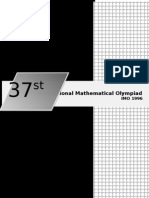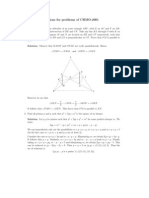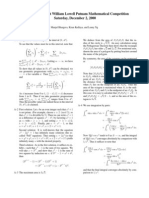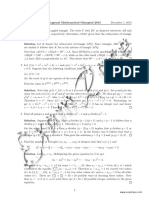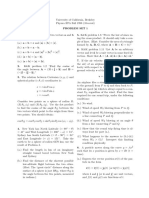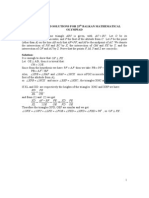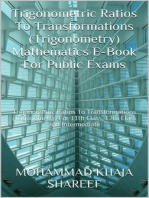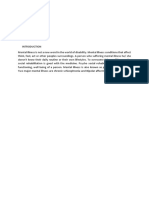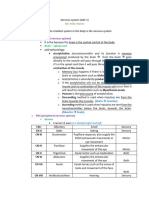New Zealand Maths Olympiad Committee Friday Test, Solutions Camp 2006
New Zealand Maths Olympiad Committee Friday Test, Solutions Camp 2006
Uploaded by
Chuông GióCopyright:
Available Formats
New Zealand Maths Olympiad Committee Friday Test, Solutions Camp 2006
New Zealand Maths Olympiad Committee Friday Test, Solutions Camp 2006
Uploaded by
Chuông GióOriginal Title
Copyright
Available Formats
Share this document
Did you find this document useful?
Is this content inappropriate?
Copyright:
Available Formats
New Zealand Maths Olympiad Committee Friday Test, Solutions Camp 2006
New Zealand Maths Olympiad Committee Friday Test, Solutions Camp 2006
Uploaded by
Chuông GióCopyright:
Available Formats
New Zealand Maths Olympiad Committee Friday Test, Solutions Camp 2006
1. Let a and b be two integers such that a b mod 3 (that is, 3 is a divisor of their dierence). Show that: 2 2 (a + ab + b2 ) 3 is an integer which can be written as the sum of three perfect squares. Solution: Let b = a + 3k, so k is an integer. Then: 2 2 (a + ab + b2 ) = 2a2 + 6ak + 6k 2 = (a + 2k)2 + (a + k)2 + k 2 . 3 2. A set {a, b, c} of three positive integers is addled if one of its elements is the sum of the other two. Does there exist a partition of {1, 2, . . . , 6018} into 2006 addled sets? Solution: No such partition is possible. The sum of the elements in an addled set is equal to twice its largest member. So, if such a partition existed, the sum of all the elements belonging to the addled sets would be even. But this is the same as the sum of the numbers from 1 through 60018, which equals (6018)(6019)/2 and is odd. 3. A segment AB of length 1 is part of a line tangent to a circle at A. The centre of is O. A square is constructed so that one side lies on AB, one vertex is on , and the fourth vertex is on line OB. Find the side length, s, of this square in terms of the radius r of the circle. Also nd the value of r which maximises s. Solution:
O
r E s A C D B F
Using similar triangles OF G and OBA we get: BA FG = , GO AO Solving, and subtracting s we get: EG = or FG 1 = . rs r
rs s. r
Use the Pythagorean theorem on OGE to get: rs s r
2
+ (r s)2 = r2 .
Simplifying, and removing a factor of r s we get: r s 2s 2s = 0 r2 r which gives: s= 1 r = . 2r2 + 2r + 1 2r + 1/r + 2
Since the product of 2r and 1/r is xed, the sum is minimised when the two quantities are equal, that is, when r = 1/ 2. 4. For which positive integers n is it possible to nd a sequence of n positive integers whose sum is equal to the square root of their product? Solution: taking: This is possible for n = 1 (take 1), not for n = 2 (because (a + b)2 > ab), and for all n 3 n + 6, n + 6, 9, 1, 1, . . . , 1 where there are n 3 1s. 5. In an acute angled triangle ABC, CF is an altitude with F on AB and BM is a median with M on AC. Given that M BC = F CA, prove that AB = BC. Solution: Let CF and BM meet at P . Let AP produced meet BC at K. Draw the circles BP C and BP A.
B
Since ACF = CBM , the circle BP C is tangent to AC. Therefore M C 2 = M P M P . But M C = M A so M A2 = M P M B. Therefore the circle BP A is tangent to AC at A, and so CAP = ABP . Hence AP C = = = 180 P AC P CA 180 ABP CBP 180 B
Therefore F P BK is cyclic. So AKB = 90 and P is the orthocentre of ABC. So AM AC and hence AB = BC. 6. Let x1 , x2 , . . . , xn be positive real numbers, with sum S. Suppose that (n 1)xk < S for all k. Prove that: (S (n 1)x1 ) (S (n 1)x2 ) (S (n 1)xn ) x1 x2 xn and determine when equality occurs.
Solution: Observe that:
(S (n 1)xk ) = nS (n 1)S = S.
k=1
So (S (n 1)xk ) = S (S (n 1)xj ) = (n 1)xj .
k=j
So by AM-GM: xj
k=j
(S (n 1)xk )1/(n1)
for all j. Multiplying these inequalities together with j running from 1 through n gives the required result. Equality holds when it holds in all instances of the AM-GM, which for n > 2 requires that all the xs be equal. For n < 2 equality always holds. 7. Find all pairs (x, y) of positive integers satisfying the equation: (x + y)x = xy .
Solution: Since the LHS is larger than xx we get y > x. Let y = qx where q is rational. We obtain: (x + qx)x = xqx Raise both sides to the 1/x and divide by x: 1 + q = xq1 . The power on the RHS is either irrational or an integer, but the LHS is rational, so must be an integer. So q is actually an integer greater than 1. If q = 2 we get x = 3, y = 6. If q = 3 we get x = 2, = 6. Since x 2 we need 1 + q 2q1 which fails for q 4. So the required pairs are (2, 6) and (3, 6). 8. Let m and n be positive integers and suppose that an m n rectangle is coloured checkerboard style with unit squares such that the lower left corner is black. Draw the diagonal of the rectangle from upper left to lower right and let f (m, n) denote the absolute value of the dierence between the area of the black part and the white part of the triangle below the diagonal. Compute f (m, n) if both m and n are even or both are odd. Show that for any constant C > 0 there are m and n such that f (m, n) > C. Solution: If the parity of m and n are the same then a 180 rotation around the centre of the diagonal preserves the colouring and sends the lower triangle to the upper triangle. So the value of f (m, n) is half the dierence between the number of black squares and the number of white squares in the rectangle, that is 0 if both m and n are even, and 1/2 if they are odd. For the second part consider f (m, m 1). The value of this will be equal to the dierence between the black and white areas in a thin triangle wedged between the diagonal of an m m square and the diagonal of the m (m 1) square. This wedge is covered by small black and white triangles, and the bases and heights of the white triangles form an arithmetic progression. Summing these up we nally get f (m, m 1) = (m + 1)/6 which can be made arbitrarily large.
You might also like
- The Hunchback of Notre DameDocument30 pagesThe Hunchback of Notre DameLivia Kogîlniceanu100% (1)
- The Online Math Open Fall Contest Official Solutions October 25 - November 5, 2019Document25 pagesThe Online Math Open Fall Contest Official Solutions October 25 - November 5, 2019AGNIBESH BHANJANo ratings yet
- Sum of Squares - Pham Kim HungDocument6 pagesSum of Squares - Pham Kim HungChuông Gió100% (1)
- 2011 SelectionSolutions PDFDocument5 pages2011 SelectionSolutions PDFDavid DavidNo ratings yet
- Problems and Solutions: INMO 2013Document4 pagesProblems and Solutions: INMO 2013ashu_dwy8605No ratings yet
- Canadian Open Mathematics Challenge: The Canadian Mathematical SocietyDocument13 pagesCanadian Open Mathematics Challenge: The Canadian Mathematical Societyสฮาบูดีน สาและNo ratings yet
- Problems and Solutions: INMO 2013Document4 pagesProblems and Solutions: INMO 2013hiralalnhpcNo ratings yet
- NUSAMO Solutions FinalDocument10 pagesNUSAMO Solutions FinalThis is my nameNo ratings yet
- Solutions To The 62nd William Lowell Putnam Mathematical Competition Saturday, December 1, 2001Document3 pagesSolutions To The 62nd William Lowell Putnam Mathematical Competition Saturday, December 1, 2001anon020202No ratings yet
- Comc2000 Official Solutions en PDFDocument10 pagesComc2000 Official Solutions en PDFafaflotfi_155696459No ratings yet
- Asian Pacific Mathematics Olympiads-1989-2009Document79 pagesAsian Pacific Mathematics Olympiads-1989-2009ptruong87No ratings yet
- IMO 1959-2003 Solved by John Scoles (Kalva) PDFDocument235 pagesIMO 1959-2003 Solved by John Scoles (Kalva) PDFDgjjkNo ratings yet
- 37th IMO 1996-FIXDocument6 pages37th IMO 1996-FIXGuffran septiahadi100% (1)
- Canadian Open Mathematics Challenge: The Canadian Mathematical SocietyDocument10 pagesCanadian Open Mathematics Challenge: The Canadian Mathematical Societyสฮาบูดีน สาและNo ratings yet
- Solutions For Problems of CRMO-2001Document4 pagesSolutions For Problems of CRMO-2001Shubham ShreshthaNo ratings yet
- 36th Imo 1995-FixDocument5 pages36th Imo 1995-FixGuffran septiahadiNo ratings yet
- SolutionsDocument3 pagesSolutionsAch JohnNo ratings yet
- Apmo2008 SolDocument8 pagesApmo2008 SolSơn TèoNo ratings yet
- Inmo-2012 Previous Year Question Papers of Indian National Mathematical Olympiad (INMO) With SolutionsDocument6 pagesInmo-2012 Previous Year Question Papers of Indian National Mathematical Olympiad (INMO) With SolutionsAkshay PandeyNo ratings yet
- Heron TrianglesDocument13 pagesHeron TriangleshumejiasNo ratings yet
- 32th Imo 1991-FixDocument6 pages32th Imo 1991-FixGuffran septiahadiNo ratings yet
- Solutions To The 61st William Lowell Putnam Mathematical Competition Saturday, December 2, 2000Document3 pagesSolutions To The 61st William Lowell Putnam Mathematical Competition Saturday, December 2, 2000Benny PrasetyaNo ratings yet
- IOQM 2023 ClarificationsDocument3 pagesIOQM 2023 Clarifications5 Aditya Kr. 8CNo ratings yet
- INMO 2012 Paper With SolutionDocument6 pagesINMO 2012 Paper With SolutionDascaliuc DanielNo ratings yet
- RMO Solved PaperDocument8 pagesRMO Solved PaperAbhishek SinghNo ratings yet
- COL National 2016Document4 pagesCOL National 2016Vicente TorresNo ratings yet
- USAMO03 SDocument17 pagesUSAMO03 SMacxsimusNo ratings yet
- 2010 ArmlDocument45 pages2010 ArmlQuang Đào VũNo ratings yet
- SMO (O) Mock PaperDocument15 pagesSMO (O) Mock PaperKhor Shi-Jie100% (2)
- 2009SummerCamp WarmUpProblemsDocument4 pages2009SummerCamp WarmUpProblemsdaud hasanNo ratings yet
- Heron Triangles: A Gergonne-Cevian-and-Median Perspective: A, B, C: ) S (S A) (S B) (S C), SDocument8 pagesHeron Triangles: A Gergonne-Cevian-and-Median Perspective: A, B, C: ) S (S A) (S B) (S C), SBoris Mendoza PortolatinoNo ratings yet
- 2011 Turkish Mathematical Olympiad SolutionsDocument5 pages2011 Turkish Mathematical Olympiad Solutionssarji elijah bonaNo ratings yet
- Arquivo Único Berkeley PDFDocument289 pagesArquivo Único Berkeley PDFEdney MeloNo ratings yet
- 12a Olym 2Document299 pages12a Olym 2micaelcarinhanhaNo ratings yet
- BMO 2008 Problems SolutionDocument4 pagesBMO 2008 Problems SolutionjfmarquesNo ratings yet
- JBMO 2019 - Problems and SolutionsDocument6 pagesJBMO 2019 - Problems and SolutionsGasNo ratings yet
- Iran Math Olympiad Second Round 1997 - 2010Document27 pagesIran Math Olympiad Second Round 1997 - 2010SamsuKopaNo ratings yet
- Mumbai 2015RMODocument5 pagesMumbai 2015RMOAditya GargNo ratings yet
- 2009 Contest Entire Draft v6Document36 pages2009 Contest Entire Draft v6Quang Đào VũNo ratings yet
- Cmimc 2017 NTDocument11 pagesCmimc 2017 NTGulit Radian WiyarnoNo ratings yet
- Berkeley Math Circle - Monthly Contests - Solutions (2000-01)Document7 pagesBerkeley Math Circle - Monthly Contests - Solutions (2000-01)ElevenPlus ParentsNo ratings yet
- 2012 Putnam SolutionsDocument6 pages2012 Putnam SolutionsvishweshsinghbhadaurNo ratings yet
- 33th Imo 1992-FixDocument7 pages33th Imo 1992-FixGuffran septiahadiNo ratings yet
- 2001 Amc 12 SolutionsDocument8 pages2001 Amc 12 Solutionsslacker0001No ratings yet
- Math Majors of America Tournament For High Schools: 2014 Individual Test SolutionsDocument4 pagesMath Majors of America Tournament For High Schools: 2014 Individual Test SolutionsJoaquim MarquesNo ratings yet
- KMO Round 1 2006-2011 Solutions KOREADocument41 pagesKMO Round 1 2006-2011 Solutions KOREAbooby fischerNo ratings yet
- Geometry Solutions 2006 Rice Math Tournament February 25, 2006Document3 pagesGeometry Solutions 2006 Rice Math Tournament February 25, 2006RongLiuNo ratings yet
- Ol994 PsDocument6 pagesOl994 PsBorislav MirchevNo ratings yet
- Math Question Bank Class XDocument8 pagesMath Question Bank Class XSunil ShrivastavaNo ratings yet
- RMO 2013 Solutions ZONE 3Document2 pagesRMO 2013 Solutions ZONE 3Himansu MookherjeeNo ratings yet
- AIMO 2013 Sample PaperDocument13 pagesAIMO 2013 Sample PaperCasper LuNo ratings yet
- Se 10-11 SolDocument8 pagesSe 10-11 SolHandason TamNo ratings yet
- KVS Jmo 2016Document90 pagesKVS Jmo 2016Suhail LoyaNo ratings yet
- 38th IMO 1997-FIXDocument6 pages38th IMO 1997-FIXGuffran septiahadiNo ratings yet
- Kanada Mat OlmpDocument83 pagesKanada Mat OlmpMustafa mızrakNo ratings yet
- 2024 TASIMO BookletDocument10 pages2024 TASIMO Bookletm-1455033No ratings yet
- A-level Maths Revision: Cheeky Revision ShortcutsFrom EverandA-level Maths Revision: Cheeky Revision ShortcutsRating: 3.5 out of 5 stars3.5/5 (8)
- 10+2 Level Mathematics For All Exams GMAT, GRE, CAT, SAT, ACT, IIT JEE, WBJEE, ISI, CMI, RMO, INMO, KVPY Etc.From Everand10+2 Level Mathematics For All Exams GMAT, GRE, CAT, SAT, ACT, IIT JEE, WBJEE, ISI, CMI, RMO, INMO, KVPY Etc.No ratings yet
- Trigonometric Ratios to Transformations (Trigonometry) Mathematics E-Book For Public ExamsFrom EverandTrigonometric Ratios to Transformations (Trigonometry) Mathematics E-Book For Public ExamsRating: 5 out of 5 stars5/5 (1)
- Cyclic PolygonsDocument2 pagesCyclic Polygonskepler1729No ratings yet
- My Inequality ProjectDocument37 pagesMy Inequality Projectanmolarora59No ratings yet
- Inequalities MarathonDocument55 pagesInequalities MarathonChuông GióNo ratings yet
- Indices and Applications 3Document11 pagesIndices and Applications 3Chuông GióNo ratings yet
- New Zealand Mathematical Olympiad 2004: Math Rugby QuestionsDocument5 pagesNew Zealand Mathematical Olympiad 2004: Math Rugby QuestionsChuông GióNo ratings yet
- Berkeley Math Circle 2000-2001 Monthly Contest #7 - SolutionsDocument3 pagesBerkeley Math Circle 2000-2001 Monthly Contest #7 - SolutionsChuông GióNo ratings yet
- De Thi HSG Toan 9Document7 pagesDe Thi HSG Toan 9Chuông GióNo ratings yet
- Geometry Marathon MathlinksDocument33 pagesGeometry Marathon MathlinksChuông Gió100% (1)
- Final - Docx 0Document3 pagesFinal - Docx 0Allan AutidaNo ratings yet
- Describing People, Places and Things EditDocument21 pagesDescribing People, Places and Things EditzaskyaNo ratings yet
- Reported SpeechDocument8 pagesReported Speechlotusk kkkNo ratings yet
- NELC Learning Resource No.7Document70 pagesNELC Learning Resource No.7marylove llubitNo ratings yet
- Patients Rights: Right To Appropriate Medical Care and Humane TreatmentDocument3 pagesPatients Rights: Right To Appropriate Medical Care and Humane Treatmentnot your medz duranNo ratings yet
- Agm 268Document100 pagesAgm 268Robert NaiaraNo ratings yet
- Jetking Training Cum Placement ProjectDocument114 pagesJetking Training Cum Placement ProjectDakshtaPhulpagarNo ratings yet
- Nicart, Jeric-Vincent C. - Genetics LaboratoryDocument3 pagesNicart, Jeric-Vincent C. - Genetics Laboratoryebenicart0No ratings yet
- Iccms Caries Prevention and TreatmentDocument3 pagesIccms Caries Prevention and TreatmentJOHN HAROLD CABRADILLANo ratings yet
- Machado Silva 07 1Document11 pagesMachado Silva 07 1César JuradoNo ratings yet
- Physical Therapy Activity Dice A7ha5tDocument13 pagesPhysical Therapy Activity Dice A7ha5tMarie San DiegoNo ratings yet
- TNG HP Bai TP Vit Li Cau Co Dap AnDocument11 pagesTNG HP Bai TP Vit Li Cau Co Dap AnLâm Nguyễn hảiNo ratings yet
- Ece 306L - Experiment 4: Signal QuantizationDocument10 pagesEce 306L - Experiment 4: Signal QuantizationAndy CaoNo ratings yet
- Melton DNP Manuscript ApprovedDocument57 pagesMelton DNP Manuscript Approvedapi-678571963No ratings yet
- Transfer Order LatesDocument265 pagesTransfer Order LatesAaimen abbasNo ratings yet
- Review Essay - Good Faith in Public International LawDocument6 pagesReview Essay - Good Faith in Public International Lawaprajita212421No ratings yet
- Assessment of Mental HealthDocument13 pagesAssessment of Mental HealthSRUTHY MSW0% (1)
- Report of PPRA 2014 Workshop-Rawalpindi PDFDocument21 pagesReport of PPRA 2014 Workshop-Rawalpindi PDFAamir Jamal GondalNo ratings yet
- Digitized Text Final Draft 2Document7 pagesDigitized Text Final Draft 2api-253375096No ratings yet
- Characteristics of Effective Technical Communication: Section .1Document23 pagesCharacteristics of Effective Technical Communication: Section .1anjunaval02No ratings yet
- PisaDocument22 pagesPisasaking76No ratings yet
- Vicarious Liability of The StateDocument14 pagesVicarious Liability of The StateextrachutzpahNo ratings yet
- Reserch TitlesDocument2 pagesReserch TitlesClare PurisimaNo ratings yet
- Koretz, Daniel. Measuring UpDocument4 pagesKoretz, Daniel. Measuring UprafadrimarquesNo ratings yet
- Wbjee 2011 Question Paper With SolutionDocument56 pagesWbjee 2011 Question Paper With SolutionPremKumarKalikiri100% (1)
- 21stCENTURY PORTFOLIO BRIOSODocument16 pages21stCENTURY PORTFOLIO BRIOSOFranchesca Mekila TuradoNo ratings yet
- PV RT: Equations of StateDocument11 pagesPV RT: Equations of StateJeff HardyNo ratings yet
- Neurologic Intensive ReviewerDocument10 pagesNeurologic Intensive ReviewerAllysa PrestonNo ratings yet
- Greetings & IntroductionsDocument2 pagesGreetings & IntroductionseyemanNo ratings yet












